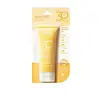Somethinc Holyshield! UV Watery Sunscreen Gel SPF 50+ PA++++ Versus Wardah UV Shield Essential Sunscreen Gel SPF 30
What's inside
What's inside
 Key Ingredients
Key Ingredients

 Benefits
Benefits

 Concerns
Concerns

 Ingredients Side-by-side
Ingredients Side-by-side

Water
Skin ConditioningEthylhexyl Methoxycinnamate
UV AbsorberButylene Glycol
HumectantButyl Methoxydibenzoylmethane
UV AbsorberOctocrylene
UV AbsorberAmmonium Polyacryloyldimethyl Taurate
Emulsion StabilisingPolymethyl Methacrylate
Phenoxyethanol
PreservativePropylene Glycol
HumectantAroma
Triethanolamine
BufferingTrimethoxybenzylidene Pentanedione
AntioxidantPolyglyceryl-4 Caprate
EmulsifyingLecithin
EmollientDisodium EDTA
Ethylhexylglycerin
Skin ConditioningCaesalpinia Spinosa Fruit Pod Extract
Helianthus Annuus Sprout Extract
Skin ConditioningSodium Benzoate
MaskingWater, Ethylhexyl Methoxycinnamate, Butylene Glycol, Butyl Methoxydibenzoylmethane, Octocrylene, Ammonium Polyacryloyldimethyl Taurate, Polymethyl Methacrylate, Phenoxyethanol, Propylene Glycol, Aroma, Triethanolamine, Trimethoxybenzylidene Pentanedione, Polyglyceryl-4 Caprate, Lecithin, Disodium EDTA, Ethylhexylglycerin, Caesalpinia Spinosa Fruit Pod Extract, Helianthus Annuus Sprout Extract, Sodium Benzoate
Water
Skin ConditioningEthylhexyl Methoxycinnamate
UV AbsorberPropylene Glycol
Humectant4-Methylbenzylidene Camphor
UV AbsorberAcrylates Copolymer
Polyacrylamide
Butyl Methoxydibenzoylmethane
UV AbsorberDimethicone
EmollientPanthenol
Skin ConditioningCyclopentasiloxane
EmollientTriethanolamine
BufferingPhenoxyethanol
PreservativeC13-14 Isoparaffin
EmollientAloe Barbadensis Leaf Extract
EmollientLaureth-7
EmulsifyingDimethicone Crosspolymer
Emulsion StabilisingCarbomer
Emulsion StabilisingTocopheryl Acetate
AntioxidantDisodium EDTA
Triethylene Glycol
MaskingDimethicone/Vinyl Dimethicone Crosspolymer
Skin ConditioningDimethiconol
EmollientPotassium Sorbate
PreservativeSodium Benzoate
MaskingWater, Ethylhexyl Methoxycinnamate, Propylene Glycol, 4-Methylbenzylidene Camphor, Acrylates Copolymer, Polyacrylamide, Butyl Methoxydibenzoylmethane, Dimethicone, Panthenol, Cyclopentasiloxane, Triethanolamine, Phenoxyethanol, C13-14 Isoparaffin, Aloe Barbadensis Leaf Extract, Laureth-7, Dimethicone Crosspolymer, Carbomer, Tocopheryl Acetate, Disodium EDTA, Triethylene Glycol, Dimethicone/Vinyl Dimethicone Crosspolymer, Dimethiconol, Potassium Sorbate, Sodium Benzoate
 Reviews
Reviews

Ingredients Explained
These ingredients are found in both products.
Ingredients higher up in an ingredient list are typically present in a larger amount.
Also known as Avobenzone, this ingredient is a chemical sunscreen filter that provides protection in the UV-A range.
Avobenzone is globally approved and is the most commonly used UV-A filter in the world.
Studies have found that avobenzone becomes ineffective when exposed to UV light (it is not photostable; meaning that it breaks down in sunlight). Because of this, formulations that include avobenzone will usually contain stabilizers such as octocrylene.
However, some modern formulations (looking at you, EU!) are able to stabilize avobenzone by coating the molecules.
Avobenzone does not protect against the UV-B range, so it's important to check that the sunscreen you're using contains other UV filters that do!
The highest concentration of avobenzone permitted is 3% in the US, and 5% in the EU.
Learn more about Butyl MethoxydibenzoylmethaneDisodium EDTA plays a role in making products more stable by aiding other preservatives.
It is a chelating agent, meaning it neutralizes metal ions that may be found in a product.
Disodium EDTA is a salt of edetic acid and is found to be safe in cosmetic ingredients.
Learn more about Disodium EDTAEthylhexyl Methoxycinnamate is an organic compound that provides UVB protection. It often goes by the more common name of octinoxate. It is created from methoxycinnamic acid and 2-ethylhexanol.
Ethylhexyl Methoxycinnamate absorbs UVB rays with wavelengths between 280-320 nm. UV absorbers protect your skin by using chemical reactions to convert UV rays into heat and energy.
UVB (290-320 nm) rays emit more energy than UVA rays. They are capable of damaging DNA, causing sunburns and are thought to be linked to skin cancer.
The state of Hawaii has banned sunscreens containing octinoxate due to its potential impact on coral reefs. More research is needed to bridge gaps in this research. The European Union allows higher levels of octinoxate in sunscreens than the US and Australia.
Ethylhexyl Methoxycinnamate is oil soluble. It is not stable and may lose efficacy when exposed to sunlight.
Learn more about Ethylhexyl MethoxycinnamatePhenoxyethanol is a preservative that has germicide, antimicrobial, and aromatic properties. Studies show that phenoxyethanol can prevent microbial growth. By itself, it has a scent that is similar to that of a rose.
It's often used in formulations along with Caprylyl Glycol to preserve the shelf life of products.
Propylene Glycol is an odorless, colorless liquid. As a humectant, it helps skin retain moisture. It also aids in delivering active ingredients.
Another role of this ingredient is preventing a product from melting or freezing. Propylene glycol also adds antimicrobrial properties to a product, elongating product lifespan.
This ingredient is considered an organic alcohol and commonly added into both cosmetics and foods.
Those with sensitive skin or conditions may develop a rash when using this ingredient.
Learn more about Propylene GlycolSodium Benzoate is a preservative. It's used in both cosmetic and food products to inhibit the growth of mold and bacteria. It is typically produced synthetically.
Both the US FDA and EU Health Committee have approved the use of sodium benzoate. In the US, levels of 0.1% (of the total product) are allowed.
Sodium benzoate works as a preservative by inhibiting the growth of bacteria inside of cells. It prevents the cell from fermenting a type of sugar using an enzyme called phosphofructokinase.
It is the salt of benzoic acid. Foods containing sodium benzoate include soda, salad dressings, condiments, fruit juices, wines, and snack foods.
Studies for using ascorbic acid and sodium benzoate in cosmetics are lacking, especially in skincare routines with multiple steps.
We always recommend speaking with a professional, such as a dermatologist, if you have any concerns.
Learn more about Sodium BenzoateTriethanolamine is an emulsifier and pH adjuster. It is created using ethylene oxide and ammonia. This gives Triethanolamine a nitrogen core and a similar scent to ammonia.
As an emulsifier, it prevents ingredients from separating and enhances texture by adding volume to a product.
PH adjusters are common in cosmetic products. The pH of a product can affect the effectiveness of other ingredients. A product with a high pH may also irritate the skin.
Learn more about TriethanolamineWater. It's the most common cosmetic ingredient of all. You'll usually see it at the top of ingredient lists, meaning that it makes up the largest part of the product.
So why is it so popular? Water most often acts as a solvent - this means that it helps dissolve other ingredients into the formulation.
You'll also recognize water as that liquid we all need to stay alive. If you see this, drink a glass of water. Stay hydrated!
Learn more about Water